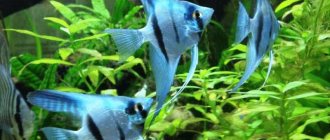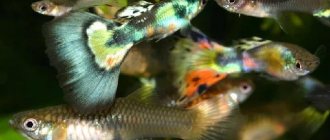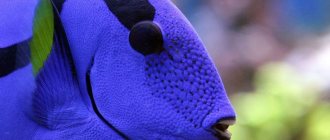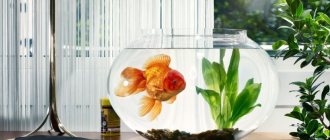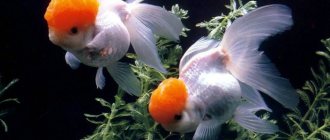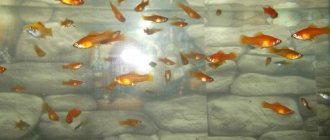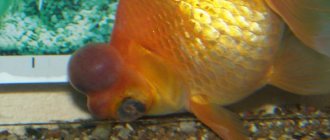The blue dolphin (lat. Cyrtocara moorii, English Blue Dolphin) is an unusual aquarium cichlid native to Lake Malawi in Africa. It is popular among cichlid enthusiasts, primarily for its coloring, as well as its unusual body shape with a large fatty bump.
These are quite large aquarium fish, and can reach a size of 25 cm or more. They are quite peaceful, but males are aggressive towards each other, and it is better to keep them in a harem, consisting of one male and three or four females.
Such a harem lives in its own territory, which it carefully guards only during spawning, remaining more tolerant at other times.
Keeping them is quite simple, provided that they live in a spacious aquarium, the water in it is stable and clean, and it is properly decorated.
It is best to design it in the form of a biotope, with sand as soil, a large number of stones and various shelters, and enough free space for swimming.
Difficulty in content
A fish that can be recommended to both experienced and advanced aquarists. They are not very suitable for beginners, as they need a spacious aquarium, frequent water changes and properly selected neighbors.
Although these are fairly peaceful fish, they are still not suitable for keeping in community aquariums.
The best neighbors for blue dolphins would be other Malawians or African catfish.
Diseases
Basically, the blue dolphin cichlid does not get sick if it is kept in proper conditions, namely clean water. It is important to maintain the correct diet and balance of nutrition to prevent obesity in individuals.
- The fish has a swollen abdomen, constipation and redness near the anus - you are probably feeding the wrong food. It is necessary to reconsider nutrition.
- The fish began to have convulsions, the color became less bright, there was no orientation in space - probably toxic elements from the water entered the animal’s body. Change the water immediately and provide the aquarium with a filter system.
- Mucus appeared on the body of the fish, their color became less bright, they became inactive - perhaps the cichilids were hypothermic. For treatment, increase the water temperature, improve air exchange, and provide food that is easy to digest.
Feeding
In nature, they are omnivorous predators that feed on a variety of benthos. In the aquarium they eat all types of food - artificial, live, frozen, plant-based.
But, the basis should be food with a high protein content, for example tubifex or brine shrimp.
Blue dolphins also eat small fish, but you can feed them only if you are absolutely sure that the fish are not sick and will not give you an infection.
As for the popular feeding of various minced meats or mammalian meat (liver, heart, etc.), at this time it is believed that the fish’s body is unable to properly digest such meat.
Long-term feeding can lead to obesity and degeneration of internal organs, so it is best to avoid it.
Reproduction of blue dolphins
When the time comes for spawning, the male himself chooses a place to lay eggs. This could be the surface of a stone or a small hole in the ground. With its appearance (it becomes brighter), it attracts the female and lures her there, and she lays eggs (up to 90 eggs). After this, the male fertilizes the eggs. The female takes it for incubation and carries it for 2–3 weeks in the oral cavity.
When the female lays eggs, measures must be taken to ensure that nothing disturbs the fish. The aquarium should be in a quiet and calm place and, of course, except for the spawning pair, there should be no one in it - either the male will kill them, or the female will eat her eggs out of fear.
Artyom, aquarist
https://aquarium-vl.ru/forum/index.php?topic=317.0
In fact, the duration of incubation depends only on temperature conditions.
During spawning, the male protects his family. He will not allow other fish (even other male dolphins) near the eggs and fry. And the female becomes especially fearful. There were times when she swallowed all the eggs out of fear.
Since the fish cannot eat normally, some aquarists try to remove the eggs and hatch them in a separate container, but this is not always possible; the fish can simply swallow the eggs.
Natalya, experienced aquarist
https://aquarium-vl.ru/forum/index.php?topic=317.0
When the fry hatch, the female hides her babies in her mouth (at night or when they are scared).
They begin to feed the fry with live dust, which is specially sold for feeding young animals.
If other fish live in the aquarium along with the blue dolphin, then the “harem” needs to be transplanted. In the case where unpretentious fish live with Tsirtokar muri, you can remove them and leave the “harem” in their familiar environment. The couple will behave fearfully and warily.
During the first spawning, it is better not to count on rich offspring. For a successful addition to the dolphin family, there must be experience (both the owners of the aquarium and the fish themselves).
Almost always, an inexperienced female cannot withstand the forced hunger strike and “teasing” of other eating cichlids and swallows the eggs. Almost no one survives the first mark.
Leonov S.A., Volgograd
https://aquatropic.uz/forum/index.php?showtopic=1766
Maintenance and care in the aquarium
For content, volume is primarily important. Remember that fish can grow up to 25 cm and require an aquarium of at least 300 liters to keep them. The second important condition: cleanliness and stable parameters of the water in the aquarium.
In Lake Malawi, fluctuations in parameters are minimal, plus the water is very hard and has an alkaline reaction. Normal parameters for keeping will be: pH: 7.2-8.8, 10-18 dGH, water temperature 24-28°C.
If the water in your region is soft, you will have to artificially make it harder, for example by adding coral chips to the soil.
There is an opinion that water that does not meet the parameters they need destroys their vision. It is not known how true this is.
As for the design, it is better to use sand as the soil, in which dolphins love to burrow.
They don't need plants, they will either dig them up or eat them. It is better to add a lot of large stones, driftwood and other various shelters.
Type of aquarium fish "Blue Dolphin"
The blue dolphin (Cyrtocara moorii) is one of the largest cichlids. Cyrtocara muri was first found and characterized in 1902 by George Albert Boulanger. Due to the fact that it is quite possible to keep this fish in aquariums, blue dolphins are not professionally caught. Aquarists began keeping specimens of this species since 1968.
Cirtocara muri has a large head with a round growth on the forehead. This bulge makes the fish look like a dolphin. Hence its name.
Individuals of the blue dolphin can be kept even by non-professional aquarists
This species is native to Africa (Lake Malawi). This fish is found in coastal areas in sandy areas, but at not very great depths (up to 15 meters). Also, individuals of the blue dolphin live in lakes Victoria and Edward. The main criteria when choosing a natural habitat: clean and warm water, harmless neighbors and the availability of places for laying eggs.
The blue dolphin fish has an elongated body, flattened on the sides. The eyes are large and mobile, and the lips are thick. Adult males have long anal fins and a bilobed caudal fin. The dorsal and pectoral fins are small.
Alla Urazaeva, experienced aquarist
Due to the fact that there is a fatty growth on the forehead, the head of Tsirtokara Muri appears larger. Therefore, adults are very easy to distinguish from young animals. Dolphin fry are gray-blue in color. And they have dark stripes on the sides, and large dark spots near the tail and on the belly. In adults, the body color is more saturated (velvety blue). And when the male is excited, he turns dark blue. His forehead also turns yellow and dark blue stripes appear on his side. The fins of adult fish are blue.
Video: blue dolphin in an aquarium
Sex differences, behavior and character
Males are larger than females, but they can only be distinguished by size in adulthood. If all the fish were approximately the same size as fry, then by the year the males will become slightly larger than the females. The forehead of a male individual will be larger and the color more saturated. In addition, females will retain subtle stripes on their sides, and the male's fins will become larger and darker. The largest blue dolphin can reach up to a quarter of a meter (but this depends on the size of the aquarium).
Fish live up to 15 years. The blue dolphin becomes a sexually mature individual at the age of one year (at this time its length reaches 13 centimeters).
Blue dolphin fry, gray-blue color
Cichlids are generally timid and shy, so they stay fairly quiet. They behave moderately aggressively with other fish. Hostility may be towards other males or more aggressive fish.
Tsirtokar muri are polygamous. Families of these fish can consist of several individuals at once (this is one male and several females). Some aquarium enthusiasts call such schools harems. Each male can keep up to 6 females in his “harem”. Therefore, if an aquarist wants to breed a blue dolphin, then he needs to buy 10-15 fry and raise them together. When they reach a size of about 15 centimeters, females and males can be distinguished.
Dolphin is a calm, peace-loving fish! Only during spawning does it show its character (but this is normal), after which everyone lives in harmony. For 2–3 males you need 5–6 females. And only one (the strongest) will work, and over time another will replace him.
Igor, experienced aquarist
https://www.aquaforum.ua/showthread.php?t=71691
Compatibility
Quite a peaceful cichlid, but certainly not for a community aquarium. They get along well with fish of equal size, but they perceive small fish exclusively as food.
Can be kept with other Malawians, but it is advisable to avoid mbuna, as they are too aggressive and restless.
Frontosa and large African catfish, for example, veiled synodontis, will be good neighbors.
History of the name
Description of a small dolphin. The blue-lipped dolphin cichlid was first introduced from Africa, where it can grow up to 25 cm in length. In a home aquarium, a dolphin can be grown to a maximum size of 20 cm.
It is called a dolphin due to its external similarity with this mammal. At the beginning of their lives, the fry do not closely resemble dolphins, but as they grow older, a pad of adipose tissue forms on the forehead, due to which a great resemblance appears. Under the convex forehead there are large eyes and protruding lips.
Adults are light blue with faint spots. During the mating season, the male's hue becomes bright blue, his forehead turns yellow, and transverse stripes appear on his body.
Distinctive features
Compared to the inhabitants of the underwater world, Malawian cichlids have unique behavior and memorable colors. A prominent representative is the blue dolphin fish, the contents and appearance of which have ensured its popularity among aquarists.
In an adult, there is a clear resemblance to the mammal of the same name.
Introduced to Europe about 50 years ago, these fish never cease to amaze with a character that goes against the grain of other cichlids. They are peaceful, fearful, good-natured and curious. There may be skirmishes between males over territory, but in general, choosing a neighbor for the aquarium is not a problem.
A native of the African Lake Malawi in nature can reach a length of 25 cm. In an aquarium, depending on its volume, the size varies from 8 to 20 cm.
The main characteristics are as follows:
- the head is large, the eyes are mobile, there is a large fatty lump on the forehead;
- the dorsal fin is long (from the head to the base of the tail). The pectoral and ventral fins are short and thin, the tail is symmetrically bilobed;
- the body is flattened laterally, tall and slightly elongated, and has a beautiful blue color. Large dark spots are visible in its center and on the tail, and black stripes on the sides;
- young dolphins are gray-bluish with a metallic sheen. On the sides of the body there are dark transverse stripes.
During conflicts or other processes of excitement, the color of the males becomes brighter, turning blue. The throat and fins practically turn black.
Breeding
The first reproduction in an artificial environment was recorded in 1978. To be successful in this process, it is necessary to properly care and prepare the breeders. It is important to ensure proper feeding. A week before spawning, it is advisable to introduce worms into the diet. A stable result in reproduction can be obtained at the age of individuals 14-18 months and up to 8 years; an earlier period is undesirable.
The male's readiness is determined by changes in his color and behavior (chasing females and aggressiveness towards males). Before the spawning process begins, future parents prepare a special platform on the ground. Females that have collected eggs sink to the bottom to a prepared place and begin spawning games. They carry out circular movements and lay eggs. At the next turn, they suck it into the mouth and swim up to the male, forcing him to spray the water with milk. Having received them, they draw them into themselves for fertilization. The whole process lasts about 1 hour, as a result, about a hundred eggs (large, oval 2.5 mm) are laid. The pillow over the forehead increases before reproduction and becomes larger each time.
The female holds the eggs in her mouth throughout the incubation period (3 weeks). After hatching, the fry stay with her for some time, going out to play at night while the other inhabitants are sleeping. Their mother releases them only when they reach a size of 1 cm. During this period, the color of the juveniles is steel, after some time the color of the fins becomes red and dark spots appear. The number of offspring obtained is 40-60%.
With any irritating factor, the female can throw off the eggs or swallow them, so it is better to place them separately.
You can raise fry in a special incubator without a female. To preserve them, it is necessary to maintain a temperature of +27...+28 °C, maintain good water filtration and organize proper nutrition: regular and nutritious. At the first stage, the nauplii are fed with artemia and crustaceans, later vitamin supplements, tubifex and chironomids are added. The growth of the fry per month is 1-1.5 cm. After 4 cm, their outfit turns blue.
Nutrition
In nature, dolphin fish feed on crustaceans, demonstrating hunting talents. In a home tank, pets happily eat everything that the owner offers, namely:
- Live and frozen food.
- Plant food.
- Pellets and dry food.
The basis of the diet should be protein foods: brine shrimp, tubifex. Despite the fact that pets will not refuse to snack on fish or chopped meat, you cannot feed fish with these products. The fact is that light blue dolphins are not able to digest such food and can get sick.
Feed
For all fish from the cichlid group use:
The stores have a large selection of specialized food for cichlids.
- special dry food with spirulina;
- defrosted krill meat;
- gammarus;
- blanched vegetables (beans, pumpkin, cauliflower, bell peppers, green peas);
- greens (cucumber, nettle, dandelion, lettuce).
Usually, aquarists chop vegetables, herbs and seafood into a uniform mass and feed them to their pets little by little. It is recommended to store food in the freezer.
Fresh bloodworms, tubifex and minced meat are not given to fish!
Vegetable mixture can be given daily, dry food - every other day. The inhabitants of the aquarium must eat the food offered within half an hour.
Description
Dolphin fish is a large representative of aquarium cichlids. The body length of an adult reaches 30 cm. Peaceful fish coexist well, but males can be aggressive. It is better to have one male and two or three females in your home pond. The dolphin has an elongated body, and its head is decorated with a fatty lump. Life expectancy in captivity reaches 10 years.
Body color can be blue, light blue, pink, purple. The elongated body is slightly flattened at the sides. The fish has a rather large head, which resembles the head of a dolphin. The dorsal fin resembles hair, and the tail is divided into two halves. The fry are light in color, while the adult fish turn blue.

